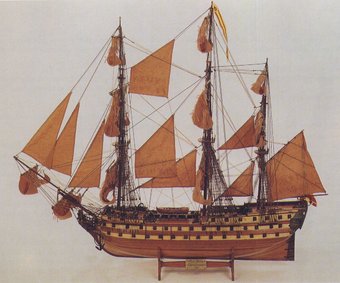San Juan Nepomuceno
 Geschichte
Geschichte 
- under construction -
Prices
All stated prices are quoted for home delivery. NOT included are local taxes and customs duties. On request we can offer prices for any place in the world!
The exact price for each ship model depends on the transport cost and on the currency exchange rate on the day of purchase. The prices quoted on this website show an approximate price for each model; an exact quotation can be given on request. The experience shows that the exact quoted price is within the given range in 98 % of all inquiries.
Delivery
Each ship model is made by hand with hundreds of man-hours. Depending on the complexity of the ship please allow 4-8 weeks for delivery. Models are shipped safely with specially designed packaging for safe delivery and easy unpacking.
Payment
50 % upon confirmation of order; 50 % on delivery; by SWIFT transfer.
 History
History 
The San Juan Nepomuceno, 2700 tons, was constructed in the royal shipyard in Guarnizo (Santander) and launched in 1765.
During the same period, the San Pascual, the Asis, the San Lorenzo, the Santo Domingo and the San Augustin were built as twin ships.
The San Juan Nepomuceno was a solidly built ship of proven seaworthy qualities.
It was outfitted with a total of 74 cannons: 24 24-pound cannons, 30 18-pound cannons, 8 12-pound cannons, 8 8-pound cannons and was manned by: 8 Officers, 11 Midshipmen, 19 Leading seamen and 492 Able seamen. Its supply capacity was for 60 days victuals and 80 days water.
It rendered numerous important services to the Armada (fleet), some of them in the Caribbean where it participated in several sieges and was distinguished in 1779.
The battle of Trafalgar is the historical feat in which it participated and of which we have the best account. In spite of being unmasted by admiral Nelson's artillery on the 21st October 1805, it achieved glory in this battle under the command of the famous Brigadier Don Cosme Damian Churruca and constituted for the Spaniards a handsome example of the heroism of their race and the bravery of their sailors. The wounded Admiral Nelson continued to direct the battle, while the Brigadier Churruca, whose leg had been torn off by a Howitzer, the deck of his ship covered by the blood of his wounded and dead seamen, continued to voice the command "fire". However, unable to break the circle of fire formed by the six enemy ships, which counted among others with the famous Defiance, Tonnant and Dreadnought, the San Juan Nepomuceno yielded with over 400 dead and injured on board. The English obtained the victory but paid a high price in lives and material.
 Histoire
Histoire 
Le San Juan Nepomuceno, de 2700 tonnes, armé de 74 canons, fut construit dans les chantiers royaux de Guarnizo (Santander) et lancé en 1765.
Les navires jumeaux qui furent construits à la même époque pour l'Armada étaient les San Pascual, Asis, San Lorenzo, Santo Domingo, San Augustin.
Le San Juan Nepomuceno était de construction à la fois robuste et de haute qualité.
Son armement comprenait au total 74 canons dont: 24 canons de 24 livres, 30 canons de 18 livres, 8 canons de 12 livres, 8 canons de 8 livres et son équipage était composé de: 1 Commandant, 8 Officiers, 11 Sous-Officiers, 19 Aspirants, 492 Marins. Il avait une capacité de réserve de 60 jours de vivres et de 80 jours d'eau.
Il a rempli d'importantes et norebreuses missions dans l'Armada espagnole, la plupart aux Caraïbes des 1779 et a participé à de nombreux sièges.
Le fait historique dont on possède le plus de détails est la bataille de Trafalgar - 21 octobre 1805. Bien que détruit par l'artillerie de l'Amiral Nelson, le San Juan Nepomuceno sous le commandement du brigadier "Don Cosme Damian Churruca", s'est attribué la gloire et a constitué un bel exemple de l'héroisme espagnol et de la bravoure de ses marins. En effet, l'Amiral Nelson, bien que blessé, continuait à diriger la bataille, tandis que le brigadier Churruca, une jambe arrachée par un obus, le pont de son navire rempli de blessés et de cadavres, criait inlassablement le commandement "FEU". Mais il ne put rompre le cercle de feu que constituaient les six navires ennemis dont les célèbres Defiance, Tonnant et Dreadnought. Il capitula avec plus de 400 morts et blessés. Les Anglais obtinrent la victoire mais à un prix fort élevé en vies et en matériel.
